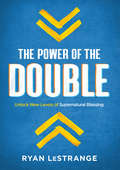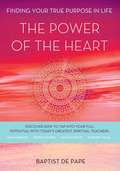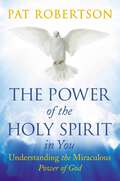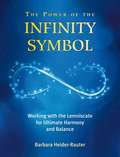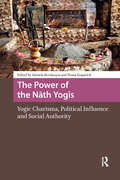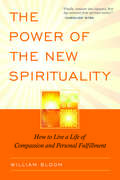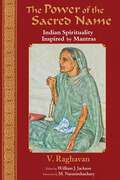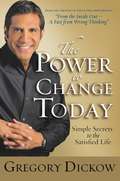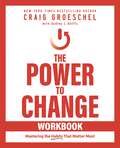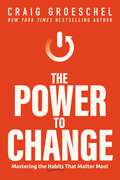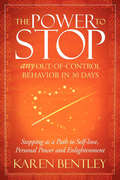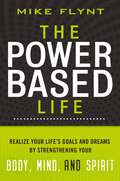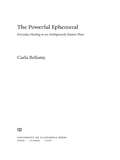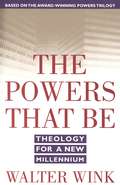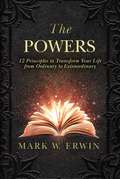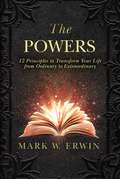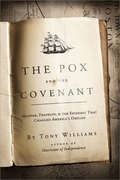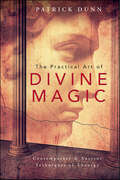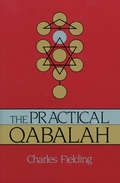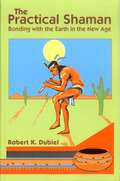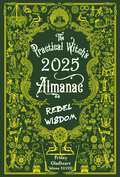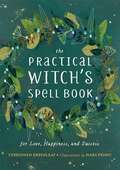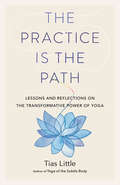- Table View
- List View
The Power of the Double: Unlock New Levels of Supernatural Blessing
by Ryan LeStrangeWhat the enemy takes, God restores doubly. There are things the enemy has snatched from your life, but God desires to give them back to you in double-double capacity. He desires to bless you so hugely that there is massive overflow in your life. Believe God not just for restoration but for a double portion. We often fight fiercely for what the enemy has stolen. But what if for every attack, you got back double? Can you imagine your finances doubling, your joy doubling, your health doubling, and your prophetic insight and wisdom doubling?The Power of the Double encourages the people of God to believe for &“double-double&” restoration. Instead of shame or guilt, poverty or lack, or anything negative the enemy has thrown at us, we can set our faith for a double portion. Ryan LeStrange challenges you to expect double-double increase and restoration for your family and future generations. Other books by Ryan LeStrange include Hell's Toxic Trio, Supernatural Access, and Overcoming Spiritual Attack.
The Power of the Heart
by Baptist De PapeWith its unprecedented convocation of eighteen of the world's greatest spiritual thinkers, writers, and scientists, including Maya Angelou, Deepak Chopra, Paulo Coelho, and Eckhart Tolle, this beautifully designed full-color spiritual guide--which ties into a film of the same name--reveals how you can overcome limitations and fulfill your highest potential.Baptist de Pape, a young lawyer, was mired in anxiety and fears about his future when he felt the call to investigate the incredible power of the heart and how it can lead us to our true purpose in life. On a quest that took him around the world, de Pape interviewed eighteen living icons--all on camera--including Isabel Allende, Jane Goodall, Marci Shimoff, Marianne Williamson, and Gary Zukav. Generously sharing their touching personal stories as well as profound guidance, these leaders co-created with de Pape a multidimensional, illuminating portrait of the heart as an inexhaustible source of love and wisdom that far surpasses that of the mind. With exciting spiritual and scientific insights, The Power of the Heart presents fascinating evidence that the heart is more than a physical organ. It possesses its own intelligence, capable of transforming your views of money, health, relationships, and success. Mindfulness exercises and contemplations guide you to activate the heart's special powers--including intuition, intention, gratitude, forgiveness, and love. These unforgettable lessons from the world's greatest teachers will inspire you to find your hidden talents, hear your inner voice, and fulfill your highest purpose in life.
The Power of the Holy Spirit in You: Understanding the Miraculous Power of God
by Pat RobertsonWho Is the Holy Spirit—and Why Do You Need Him in Your Life? After His crucifixion and resurrection, Jesus gave His disciples an assignment to change the world—but told them to wait until the power of the Holy Spirit had come upon them before setting out. His charge to modern-day believers is no different: To do the works that Jesus did (and even greater ones, as He said), it is imperative that we operate from the indwelling power of the Holy Spirit. But Who is this mysterious Third Person of the Trinity? How do we get this power, and what are we to do with it when we receive it? Pat Robertson, founder of the Christian Broadcasting Network and beloved longtime host of The 700 Club, tackles these questions and many others in this, the final book of a life that is now in its ninth decade. Robertson traces the path of the Holy Spirit through both the Old and New Testaments, and shares stories from his own life and that of many 700 Club viewers testifying to how the power of the Holy Spirit has miraculously freed and healed them today. If you want a better understanding of the Holy Spirit and are hungry to know more about the power that is available through Him to every Christfollower today, this book is for you.
The Power of the Infinity Symbol: Working with the Lemniscate for Ultimate Harmony and Balance
by Barbara Heider-RauterA guide to the spiritual meaning and magic of the infinity symbol and how to activate its positive powers • Explains how the infinity symbol is the antidote to a negative, imbalanced world and how it can help reconnect the two halves of the brain and achieve balance and harmony in yourself, your relationships, and the wider world • Offers simple and practical exercises that harness the power of the infinity symbol for balance and harmony, including simple visualizations, physical exercises, and directed drawing of the symbol • Explores the many appearances of this universal symbol in history, mythology, different cultures, and the natural world Through the ages, the infinity symbol, a sideways figure eight, has represented eternal development and balance. Also known as the lemniscate, this powerful symbol stands for equilibrium, harmony, and the interconnectedness of all things. Although magical knowledge of symbols has often been kept secret throughout history, today the power of this symbol is available to all. In this accessible, hands-on guide, Barbara Heider-Rauter explores the spiritual world of the infinity symbol in a personal and practical way, allowing each of us to benefit from its positive influence for balance and harmony in ourselves, our relationships, and the wider world. She begins with a short exercise to attune readers to the energy field of the lemniscate. She explains how the infinity symbol offers the perfect response to a system that encourages separation and a world in which the negation of our feelings is often the source of illness and pain. She details simple exercises to reconnect the two halves of the brain, the analytical and the emotional, resulting in harmony and healing. She teaches how to use simple visualisation, physical exercises, and directed drawing of the symbol to achieve practical results in our daily lives. Beautifully illustrated in full color, the book also offers a wealth of information on the appearance of the infinity symbol through the ages in all its forms and contexts, from history and mythology to our own tiny body cells and the natural world. This book urges the reader to establish wholeness, to balance the scales of duality and find harmony. With the power of the lemniscate at hand, decisions will be made with greater ease and relationships filled with harmony and a lighter heart.
The Power of the Nath Yogis: Yogic Charisma, Political Influence and Social Authority (Religion and Society in Asia)
by Daniela Bevilacqua Eloisa StuparichThe volume collects a series of contributions that help reconstruct the recent history of the Nath tradition, highlighting important moments of self reinterpretation in the sampradaya’s interaction with different social milieus. The leitmotif tying together the selection of articles is the authors’ explorations of the overlap between religious authority and political power. For example, in which ways do the Naths’ hagiographical claim of possessing yogic charisma (often construed as supernatural powers, siddhis) translate into mundane expressions of socio-political power? And how does it morph into the authority to reinterpret and recreate particular traditions? The articles approach different aspects of the recent history of the Nath sampradaya, spanning from stories of yogis guiding kings in the petty principalities of the eighteenth century to gurus who sought prominence in the transnational environments of the twentieth century; examining some Nath lineages and institutions under the British Raj, in the history of Nepal, and in contemporary India.
The Power of the New Spirituality
by William BloomEveryone has religious experiences; most people just don't know how to identify them, says author William Bloom. Carolyn Myss calls this well-known British Body-Mind-Spirit teacher a "genius" who finally "separates spiritual reality from New Age nonsense." His Power of Modern Spirituality uniquely straddles mainstream and alternative forms of belief. In commonsense, everyday language, Bloom speaks directly to the legions of people who seek to replace a single-faith tradition with a more generalized spirituality. He identifies the core similarities in all spiritual traditions and explains how everyone-regardless of background, beliefs, or personality type-can immediately put them into practice. He shows how to develop the key aspects of connection, reflection, and service in the context of today's challenges in order to gain greater meaning in our lives. He also explains the phenomenon of spiritual voices in a psychological context, and he explains how modern spirituality's ethical core is stronger even than that of traditional faiths because it includes green values and insights from developmental psychology.Written in a lively and inspiring style and drawn from Bloom's popular workshops, The Power of Modern Spirituality helps us explore ourselves more deeply. It is an invaluable tool for increasing a sense of integrity, inner strength, and personal joy. It will also help us connect more strongly with family members, friends, and colleagues and forge a sense of being in the driver's seat of our lives. Today's society makes ever-increasing demands on us. But in the practice of modern spirituality, we can find heartening new solutions that give us the energy, motivation, and inspiration to develop ourselves and transform our world.
The Power of the New Spirituality
by William BloomEveryone has religious experiences; most people just don't know how to identify them, says author William Bloom. Carolyn Myss calls this well-known British Body-Mind-Spirit teacher a "genius" who finally "separates spiritual reality from New Age nonsense." His Power of Modern Spirituality uniquely straddles mainstream and alternative forms of belief. In commonsense, everyday language, Bloom speaks directly to the legions of people who seek to replace a single-faith tradition with a more generalized spirituality. He identifies the core similarities in all spiritual traditions and explains how everyone-regardless of background, beliefs, or personality type-can immediately put them into practice. He shows how to develop the key aspects of connection, reflection, and service in the context of today's challenges in order to gain greater meaning in our lives. He also explains the phenomenon of spiritual voices in a psychological context, and he explains how modern spirituality's ethical core is stronger even than that of traditional faiths because it includes green values and insights from developmental psychology.Written in a lively and inspiring style and drawn from Bloom's popular workshops, The Power of Modern Spirituality helps us explore ourselves more deeply. It is an invaluable tool for increasing a sense of integrity, inner strength, and personal joy. It will also help us connect more strongly with family members, friends, and colleagues and forge a sense of being in the driver's seat of our lives. Today's society makes ever-increasing demands on us. But in the practice of modern spirituality, we can find heartening new solutions that give us the energy, motivation, and inspiration to develop ourselves and transform our world.
The Power of the Sacred Name: Indian Spirituality Inspired by Mantras
by V. R. RaghavanIn Hinduism, as in all of the great religious traditions from around the globe, the repeating or singing of a sacred name is an integral part of prayer and daily life. With chapters that explore the contribution of Mahatma Gandhi and Guru Nanak, the founder of Sikhism, this edited collection of the writing of renowned Indian scholar, V. Raghavan, examines the lives and contributions of the main exponents of the tradition in India.
The Power to Change Today: Simple Secrets to the Satisfied Life
by Gregory DickowHow many people go through their days feeling dissatisfied or even feeling their lives have no purpose or meaning? Perhaps money, time or love seem in short supply. Or one doesn't have the body they'd like or the perfect job or the perfect mate. What kind of faith can give the strength and encouragement to break free from emotional and spiritual discontentment?In this debut work Pastor Dickow, founder of the popular Life Changers International Church brings a compelling vision for conquering negativity and achieving breakthroughs toward successful living. Through attaining a deep connection with God one can learn the keys to mastering destructive emotions and eradicating personal stress. Pastor Dickow offers readers 16 spirit-centered and practical secrets to create an invincible spirit and a satisfied life.Direct and heartfelt in its narrative, THE POWER TO CHANGE TODAY is more than a typical self-help book. It not only includes a full discussion of spiritual and common sense wisdom, but also reveals the story of Pastor Dickow's personal journey through a painful childhood, a crisis of faith and a miracle conversion.
The Power to Change Workbook: Mastering the Habits That Matter Most
by Craig GroeschelTime-Tested Strategies for True Transformation.Nothing is more frustrating than knowing you want to change—and need to change—but repeatedly fail to change. You've made commitments and set goals. You've resolved to do something about the issue—whether you want to lose weight, read the Bible more, overcome an addiction, or get out of debt. Yet, so far, nothing has worked, and you wonder if you're even capable of change.If this sounds like your story, then it's time to change the way you think about change.In The Power to Change pack (which includes the book and the accompanying workbook), pastor Craig Groeschel, author of Winning the War in Your Mind, blends biblical wisdom with up-to-date psychology to help you learn how to master the habits that lead to true change. In each chapter and section, you'll gain practical tools that will help you:Evaluate how you view yourself, how you view God, and the real reasons you do what you do.Discover how to master small habits that lead to big change.Employ the reap-sow principle to change the trajectory of your future.Lean on God's power—instead of your willpower—as the true cause of lasting change. The Power to Change pack offers you a clear path with practical tools, exercises, spiritual insights, and applications to help you live the life that God created you to experience. It's time to rely on a greater power source than your will and determination. It's time to actually change.This pack includes:The Power to Change book.The Power to Change Workbook.
The Power to Change: Mastering the Habits That Matter Most
by Craig GroeschelFeeling stuck no matter how hard you try to make positive changes in your life? You can start living the life you want through the practical, biblical, and highly doable strategies in The Power to Change.Few things in life are more frustrating than knowing you need to change, wanting to change, and trying to change, but not changing. Craig Groeschel knows what it's like to be caught in that demoralizing cycle. That was his own story--until he discovered practical principles for experiencing lasting change. Since then, Craig has helped countless others find true change in their relationships, habits, and thoughts.In The Power to Change, Craig helps you understand:How God's power, not your willpower, leads to true transformationThe real reasons you do what you doWhy falling isn't failureThe power of creating small habits that lead to big changeHow to choose what you want most over what you want now A powerful blend of biblical wisdom and fascinating psychology, The Power to Change includes helpful exercises, real-life stories, and life-changing spiritual insights. Whether you are trying to lose weight, breathe new life into your marriage, read the Bible more, get out of debt, or give up an addiction, Craig's step-by-step, time-tested strategies will equip you to start living the life God wants for you.
The Power to Stop Any Out-of-Control Behavior in 30 Days: Stopping as a Path to Self-Love, Personal Power and Enlightenment
by Karen BentleyLOVE IS THE SOLUTION! The Power to Stop is a 30-day do-it-yourself spiritual recovery training program that teaches how to stop out-of-control behaviors, bad habits or substance abuse problems. The secret of success is the experience of self-love, which is learned through four practical, easy stopping skills. The Power to Stop accelerates personal growth, restores connection with God and renews deep, rich meaning in life. Take the happy leap from wasting your life to saving it with love.
The Power-Based Life: Realize Your Life's Goals and Dreams by Strengthening Your Body, Mind, and Spirit
by Mike FlyntThe two greatest days in our lives are the day we're born and the day we realize what we were born for.Do you know what you were born for? For years Mike Flynt--a college football player turned insurance salesman--certainly didn't. Then one monumental day he stumbled into what he now believes is the career he was made for and, in turn, the life he was meant to live.The Power-Based Life was developed out of Mike's desire to help others discover who God created them to be and, consequently, the work they were designed to do. But what exactly is a power base? As Mike explains through heartfelt personal accounts, notable sports stories, and biblical references, a power base is the center of personal strength used to meet challenges that, once discovered and maximized, will lead to a more significant, satisfying, and successful life.He offers twelve strategies designed to tap into your specific points of personal strength, such as Cultivate a Winning Attitude, Defy the Skeptics, and Practice Radical Mercy. These principles empower you to rise above life's challenges and identify and embrace your goals and dreams. Find true meaning in your work and how you can impact the world by strengthening your body, mind, and spirit.
The Powerful Ephemeral: Everyday Healing in an Ambiguously Islamic Place
by Carla BellamyThe violent partitioning of British India along religious lines and ongoing communalist aggression have compelled Indian citizens to contend with the notion that an exclusive, fixed religious identity is fundamental to selfhood. Even so, Muslim saint shrines known as dargahs attract a religiously diverse range of pilgrims. In this accessible and groundbreaking ethnography, Carla Bellamy traces the long-term healing processes of Muslim and Hindu devotees of a complex of dargahs in northwestern India. Drawing on pilgrims' narratives, ritual and everyday practices, archival documents, and popular publications in Hindi and Urdu, Bellamy considers questions about the nature of religion in general and Indian religion in particular. Grounded in stories from individual lives and experiences, The Powerful Ephemeral offers not only a humane, highly readable portrait of dargah culture, but also new insight into notions of selfhood and religious difference in contemporary India.
The Powers That Be: Theology for A New Millennium
by Walter WinkIn our fast-paced secular world, God and theology are second-class citizens. Money, politics, sports, and science seem better suited to the hard realities of our world. As the church steeple has been eclipsed by the skyscraper as the centerpiece of the urban landscape, so has the divine realm been set aside in favor of more immediate human experience. One sad consequence of this shift is the loss of spiritual and theological bearings, most clearly evident in our inability to understand or speak abou...
The Powers: 12 Principles to Transform Your Life from Ordinary to Extraordinary
by Mark W. ErwinIt’s time to discover your powers.The Powers is written for people who have a drive to become highly successful in their chosen field of endeavor. Throughout this book you will meet many who came from ordinary backgrounds to achieve extraordinary things in a variety of pursuits. They came from different circumstances with a wide range of gifts as well as many personal limitations. All have experienced failure and some were serial failures. The Powers they discovered within themselves are the same Powers Erwin has identified and discusses. Through study, they can become your Powers.While everyone has different dreams and goals, they also possess their own set of Powers, even if some are hidden deep within. Erwin has found that intellectual curiosity, developing a grand vision, setting clear goals, practicing persistence, and other concepts included in this book are common traits among the most successful people. After years of studying works by great authors such as Napoleon Hill, Norman Vincent Peale, and Dale Carnegie, befriending highly successful people, and exploring an experimental learning style, Erwin has found common traits that not only create success but also allow one to go from ordinary to extraordinary.Mark Erwin has mentored hundreds of people, both young and old, and has collected life-changing lessons throughout his journey that brought him from a sixteen-year-old in a jail cell to a multimillionaire before he was forty. In The Powers, he shares personal stories, philosophical and practical advice, and a one-of-a-kind collection of wisdom and insights from some of the most successful people in history, many of whom are friends.This book creates the blueprint for you to become exceptionally successful and maps out how using the Powers, in combination with your unique personality and emotional intelligence, will help you stand out and make a difference in whatever area you choose to pursue.Read and reread this book and your true path for success on your terms will be revealed, and you will know exactly how to make your dreams come true.
The Powers: 12 Principles to Transform Your Life from Ordinary to Extraordinary
by Mark W. ErwinThe Powers is written for people who have a drive to become highly successful in their chosen field of endeavor. Throughout this revised edition, you will meet many who came from ordinary backgrounds to achieve extraordinary things in a variety of pursuits. They came from different circumstances with a wide range of gifts as well as many personal limitations. All have experienced failure and some were serial failures. The Powers they discovered within themselves are the same Powers Erwin has identified and discusses. Through study, they can become your Powers. While everyone has different dreams and goals, everyone also possesses their own set of Powers, even if some are hidden deep within. Erwin has found that intellectual curiosity, developing a grand vision, setting clear goals, practicing persistence, and other concepts included in this book are common traits among the most successful people. After years of studying works by great authors such as Napoleon Hill, Norman Vincent Peale, and Dale Carnegie, befriending highly successful people, and exploring an experimental learning style, Erwin has found common traits that not only create success but also allow one to go from ordinary to extraordinary. Mark Erwin has mentored hundreds of people, and has collected life-changing lessons throughout his journey that brought him from a sixteen-year-old in a jail cell to a multimillionaire before he was forty. In The Powers, he shares personal stories, philosophical and practical advice, and a one-of-a-kind collection of wisdom and insights from some of the most successful people in history, many of whom are his friends. This book creates the blueprint for you to become exceptionally successful and maps out how using the Powers, in combination with your unique personality and emotional intelligence, will help you stand out and make a difference in whatever area you choose to pursue. Read and reread this book and your true path for success on your terms will be revealed, and you will know exactly how to make your dreams come true.
The Pox and the Covenant
by Tony WilliamsFor one hundred years, God had held to his promise, and the colonists had as well. When the first Puritans sailed into Massachusetts in the seventeenth century, weak from the ocean journey, they formed a covenant with each other and with God to establish a city on a hill-a commitment to live uncorrupted lives together or all suffer divine wrath for their collective sin. But now, a century later, the arrival of one doomed ship would put this covenant to its greatest test. On April 22, 1721, the HMS Seahorse arrived in Boston from the West Indies, carrying goods, cargo, and, unbeknownst to its crew, a deadly virus. Soon, a smallpox epidemic had broken out in Boston, causing hundreds of deaths and panic across the city. The clergy, including the famed Cotton Mather, turned to their standard form of defense against disease: fasting and prayer. But a new theory was also being offered to the public by the scientific world: inoculation. The fierce debate over the right way to combat the tragedy would become a battle between faith and reason, one that would set the city aflame with rage and riot. The Pox and the Covenant is a story of well known figures such as Cotton Mather, James Franklin, and a young Benjamin Franklin struggling to fight for their cause among death and debate-although not always for the side one would expect. In the end, the incredible results of the epidemic and battle would reshape the colonists' view of their destiny, setting for America a new course, a new covenant, and the first drumbeats of revolution.
The Practical Art of Divine Magic: Contemporary & Ancient Techniques of Theurgy
by Patrick DunnThe ancient world of Egypt, Greece, and Rome was home to a set of magical and spiritual technologies, called theurgy, that unite the practice of magic with the aims of religion. Theurgy, or "godwork," is the art of creating a stronger bond between the theurgist and his or her deities. The results of this stronger bond were imminently practical: stronger magic, more meaningful existence, and a better life. With the fall of Rome, these techniques faded into obscurity, and many of them were lost forever.This book revives, restores, and reinvents these practices for a contemporary pagan or magical practitioner. A mixture of scholarly research and examination of source texts and daring experimentation and extrapolation leads to a complete and workable system that can inform a variety of practices, all presented in a relaxed, lighthearted, and readable way.Whether you practice witchcraft, ceremonial magic, or chaos magic, you can benefit from the practice of theurgy. You will learn techniques to create stronger bonds with divine forces, call up and communicate with spiritual beings, summon a magical assistant, create statues imbued with divine spirit, and master your own mind. The ultimate goal is union with the divine, but theurgy is a practical path, and every step on that path is designed to improve your life.
The Practical Pagan: Commonsense Guidelines for Modern Practitioners
by Dana D. EilersFrom the book: Do you revere the ancient Gods or Goddesses? Do you think there is agoddess that should be revered along with a god? Do you worship nature, and want to do all you can for her? If any of these questions trigger a response, you will want to check out this book. The author answers such questions as "How do I come out as a pagan to friends and family?" and "How do I learn about Paganism?"
The Practical Qabalah
by Charles FieldingA study of the Qabalah and its great symbol—the Tree of Life—along with the basic ideas of modern occultism in the Western world. This is an excellent introduction to the Western Mystery Tradition and the symbolism of the Qabalah. The Practical Qabalah discusses pathworking procedures of Qabalah in light of the archetypes of Jungian psychology, showing how to work with dreams and visualization to help better communicate with yourself and others. &“In many respects it remains one of the simplest, clearest and most profound expositions available on a magical and psychological approach to the Qabalah.&”—View from the Big Hills &“I highly recommend this book to anyone interested in the Qabalah with the intention of utilizing it in ritual and even everyday life practices . . . The steps required to manifest your dreams into reality are easy to follow once you know how.&”—Rev. SkwYrm
The Practical Shaman: Bonding with the Earth in the New Age
by Robert K. DubielThe result of many years of shamanic practice, &“The Practical Shaman: Bonding with the Earth in the New Age&” is a useful handbook for spiritual searchers who wish to be of service to the Earth and to their community. Author Robert K. Dubiel, Intuitive Coach and Shaman, provides the reader with many suggestions and techniques to activate their personal Light while relating to the world around them. Shamanic topics include bonding with Power Animals, Nature Spirits and Spirit Guides. Dubiel also emphasizes making friends with the Shadow self in order to transform negativity into a personal ally.&“The Practical Shaman&” contains many guided meditations, including a visualization to establish a safe internal space at a healing pool. This book emphasizes the power of conscious breathing in transforming both inner and outer reality. The reader is shown ways to activate neglected power places, create their own power spots and tune into energy vortexes on the Earth. Readers are also encourages to form service groups to energize the Earth and assist those who have passed on.Drawing from several shamanic traditions, &“The Practical Shaman&” finds the common threads in each one, including the Egyptian, the Christian and the Native American. Author Robert K. Dubiel emphasizes the step by step process of shamanic unfoldment. In the section &“Jesus as a Model Shaman&” he describes Jesus&’ public life as a series of shamanic initiations into the embodiment of his Light Body: Baptism, Service, Transfiguration, Crucifixion (Sacrifice), Resurrection and Ascension.Author Robert K. Dubiel views the shaman as someone who consciously works interdimensionally to be of service. This book focuses on the balance between one&’s personal power and the Universal Energy which we all share. In the section &“How to Receive and Store Grace&” Dubiel illustrates ways to open ourselves to the support that is always available. He also encourages the reader to make vows that will strengthen the unfoldment of their life purpose. Thus &“The Practical Shaman&” helps searchers to open their Light Body to assist in the spiritual transformation that is sweeping the planet at this time.
The Practical Witch's Almanac 2025: Rebel Wisdom
by Friday GladheartThe essential core of witchcraft is wisdom and change. We've always been rebellious and defiant, and our own traditions are not exempt from challenge. Delve into iconic witchcraft traditions like the utterance of "blessed be" and the influential Wiccan Rede, exploring their origins and relevance today. This introspective journey isn't just about history; it's an empowering quest. It challenges you to assess these traditions' place in your craft. Embrace, adapt, or boldly defy these customs—this edition empowers you to shape your craft's evolution on your terms as you travel your unique spiritual path. Includes:Weekly SchedulesMonthly Lunar PlannersMoon Signs & PhasesSabbat Times & DatesEclipses & Meteor ShowersSpells & RecipesCorrespondences & Referencesand much more!
The Practical Witch's Spell Book: For Love, Happiness, and Success
by Cerridwen Greenleaf Mara PennyA complete introduction to modern magic and witchcraft with spells and incantations for love, happiness, and success.The Practical Witch's Spell Book is an enchanting handbook for anyone with a penchant for the magical and who wants to add joy to their daily life. To practice witchcraft is to be purposeful whether it's to help heal, bring about prosperity, imbue your home with positivity, or even to fall in love. To be a practical witch is to tap into an inner place of intention, energy, and magic to bring about positive change in your life and those of your loved ones. With life's increasingly frenetic pace, a magical approach to living is more important now than ever.In this must-have guide for spell-casters of all levels you will find hundreds of spells, blessings, and incantations for love and romance, contentment and happiness, success and prosperity, health and healing, work and vocation, and money and wealth, all to enrich your mind and spirit, and to improve your life and the world around you. Also included are ritual resources, magical correspondences, lucky colors and numbers, moon spells, and all the essential tools you need for making magic.
The Practice Is the Path: Lessons and Reflections on the Transformative Power of Yoga
by Tias LittleInternationally known yoga teacher Tias Little shares powerful, inspiring wisdom from a lifetime of practice.For over 30 years, Tias Little has explored yoga as a spiritual path. In this book he offers key teachings from his journey that will resonate with anyone who has dedicated themself to a mind-body discipline. In short, accessible chapters, Little shares his struggles and joys as a yogi and chronicles the transformation of his understanding and practice along the way. There are many physical and emotional trials that come up in yoga as a spiritual practice: the urge toward perfectionism, the desire to get it all right, the way we push ourselves in the practice, being with "not-knowing," and the many ways some people use yoga as a sedative. To help the reader embody and experience each theme, Little includes companion practices at the end of each chapter including poses, reflections, meditations, and explorations.
